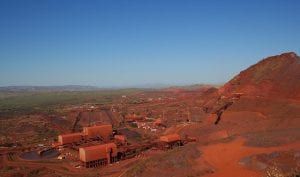Oil and gas giant Santos has made a final investment decision on the Barossa gas project in the Northern Territory that will effectively operate as a “carbon emissions factory”, with gas as a side product, according to critics.
Santos announced on Tuesday it would proceed with the $4.7 billion Barossa gas project, which will extract fossil gas with some of the world’s highest carbon dioxide content, raising fears it is about to tap into a “carbon bomb” because the greenhouse gas emissions will be vented directly into the atmosphere.
The project is expected to operate for around 20 years, and will be located in waters 300km north of Darwin. Most of the gas produced by the project is expected to be sent offshore, with Santos striking an offtake agreement with Diamond Gas International, a subsidiary of Japanese industrial giant Mitsubishi Corporation.
The gas that is set to be extracted from the Barossa gas field is already mixed with a substantial amount of carbon dioxide that will need to be extracted, and likely vented, before the fossil gas can be sent to a Darwin LNG plant for processing.
Santos CEO Kevin Gallagher said Santos would ‘investigate’ options for offsetting the emissions from the project, but has made no solid commitments.
“We will continue to explore the potential for carbon-neutral LNG from Barossa as part of our commitment to lower global emissions and as a company, reach our net-zero emissions target by 2040,” Gallagher said.
The Australasian Centre for Corporate Responsibility (ACCR) said that Santos’ commitment to ‘investigate’ carbon offsets for the gas project were a “dangerous misnomer”, doubting that any such effort would be made to capture emissions from the project.
“Santos claims that it will ‘investigate opportunities for carbon-neutral LNG’—a dangerous misnomer which must be called out. If it were that easy to reduce emissions, we would not be facing the prospect of dangerous climate change,” ACCR’s Dan Gocher said.
“As has become the norm, Santos talks of potentially capturing carbon, and potentially developing hydrogen projects. Until Santos reaches FID on these projects, they’re nothing more than thought bubbles.”
According to analysts, the Institute for Energy Economics and Financial Analysis, the Barossa gas field contains so much carbon dioxide that the mere extraction of the gas will result in the release of a greater volume of greenhouse gases than the volume of useable fossil gas produced from the gas field.
“Barossa gas has 3 times the CO2 content that the Darwin LNG plant facility can handle,” IEEFA analyst John Robert said.
“Fields like Barossa are very problematic because they contain such high emitting gas that they can never be made into acceptable LNG in the very competitive market which now is more aware of the climate impact of its product.”
Because of this, IEEFA says, it is likely a substantial volume of carbon dioxide will need to be vented from the project.
IEEFA estimates that the Barossa gas field will directly result in the release of 3.38 million tonnes of carbon dioxide each year, along with a further 2.05 million tonnes of carbon dioxide released from the Darwin LNG plant during the processing of the gas.
Combined, this will see more carbon dioxide released each year, as much as 5.43 million tonnes, than the projected 3.7 million tonnes of LNG expected produced from the Darwin LNG facility each year.
This is before the gas produced by the facility is burnt, resulting in further greenhouse emissions when eventually used overseas.
“When the venting and combustion emissions both off- and on-shore are calculated, the Barossa to Darwin LNG project looks more like a CO2 emissions factory with an LNG by-product,” Robert added.
With Australia’s largest LNG buyers, including Japan, South Korea and China, all committing to zero emissions targets, IEEFA says there is a genuine risk that emissions intensive projects like the Barossa gas field could become stranded assets, issuing a warning to Santos shareholders.
“Fields like Barossa are very problematic because they contain such high emitting gas that they can never be made into acceptable LNG in the very competitive market which now is more aware of the climate impact of its product,” Robert said.
“This is a big and real risk to proponents like Santos, SK E&S and its partners in the Barossa field and Darwin LNG plant – a plant which will most likely become a stranded asset if Barossa doesn’t go ahead. But with even more money lost if the Barossa FID is approved, investors should be particularly wary.”







